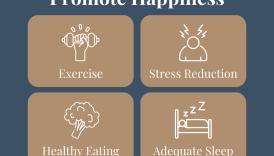From Goals to Reality: How to Implement Your Healthy Life Program

Introduction: Setting the Foundation
Understanding Your Health Goals
Setting health goals is a crucial first step on the journey to a healthier life. Identifying what you truly want to achieve—be it weight loss, increased stamina, or improved mental well-being—gives you direction. For instance, one might aspire to run a 5K within three months, turning a vague desire for fitness into a tangible goal.
- From Goals to Reality: How to Implement Your Healthy Life Program
- Introduction: Setting the Foundation
- Understanding Your Health Goals
- Importance of Implementing a Healthy Life Program
- Assessing Your Current Lifestyle
- Identifying Habits to Change
- Evaluating Your Physical Activity Levels
- Designing Your Healthy Life Program
- Setting Achievable Goals
- Creating a Realistic Action Plan
- Nutrition and Meal Planning
- Understanding Nutritional Needs
- Developing a Balanced Meal Plan
- Exercise and Fitness Routine
- Choosing the Right Workouts
- Incorporating Physical Activity into Your Daily Life
- Managing Stress and Mental Well-being
- Stress-Reduction Techniques
- Prioritizing Self-Care Practices
- Building a Support System
- Seeking Encouragement from Friends and Family
- Joining a Community or Group for Accountability
- Tracking Your Progress
- Monitoring Your Health Metrics
- Celebrating Milestones and Achievements
- Overcoming Challenges and Setbacks
- Identifying Obstacles
- Developing Resilience Strategies
- Sustaining Your Healthy Lifestyle
- Making Long-Term Changes
- Continuously Revisiting and Adjusting Your Program
- Conclusion: Embracing Your Health Journey
- Recognizing Your Growth
- Continuing the Adventure
- Specific: What do you want to achieve?
- Measurable: How will you track progress?
- Achievable: Is your goal realistic?
Reflecting on these aspects helps in crafting a focused plan.
Importance of Implementing a Healthy Life Program
Adopting a healthy lifestyle is more than just a change; it’s a transformative journey. Implementing a Healthy Life Program promotes long-term wellness and vitality. Benefits include:
- Boosted Energy Levels: You’ll feel more energetic throughout the day.
- Improved Mood: Regular exercise and balanced nutrition can enhance mental well-being.
By committing to this program, you are not just making a change for today but sowing the seeds for a vibrant future.
Assessing Your Current Lifestyle
Identifying Habits to Change
Once you have set your health goals, the next step is to take a clear-eyed look at your current habits. It’s essential to pinpoint what’s holding you back. For instance, a friend of mine discovered that her nightly snacking on chips was derailing her healthy eating efforts. To identify habits to change:
- Keep a Journal: Document daily activities and food intake to spot patterns.
- Reflect on Triggers: What prompts unhealthy choices? Stress, boredom, or social gatherings?
Recognizing these habits is the first step toward making meaningful shifts.
Evaluating Your Physical Activity Levels
Alongside habits, evaluating physical activity is crucial. Ask yourself:
- How many days a week do I exercise?
- What type of activities am I engaging in?
You might find that a simple daily walk or dancing in your living room can significantly boost your activity levels. Aim for at least 150 minutes of moderate exercise each week, and remember, every little bit counts!
Designing Your Healthy Life Program
Setting Achievable Goals
Now that you’ve assessed your current lifestyle, it’s time to transform insights into action. Setting achievable goals is crucial to maintaining motivation and clarity. Instead of aiming to lose 20 pounds in a month—which can be overwhelming—try targeting 1-2 pounds weekly. When setting your goals, keep the SMART criteria in mind:
- Specific: Clearly define what you want.
- Measurable: Ensure you can track your progress.
- Achievable: Set realistic targets.
- Relevant: Goals should align with your overall health objectives.
- Time-bound: Assign a timeline for accountability.
Creating a Realistic Action Plan
With your goals established, create a realistic action plan. This is your roadmap. For example, if weight loss is a priority, consider planning simple weekly meal prep days to ensure healthy choices are always available.
- Daily Activities: Incorporate 30 minutes of exercise, like brisk walking.
- Meal Planning: Dedicate Sundays to prepare healthy meals.
By breaking your goals into smaller, actionable steps, you’ll find them more manageable and less daunting. Embrace this structure, and watch your progress unfold!
Nutrition and Meal Planning
Understanding Nutritional Needs
With your action plan in place, it’s essential to prioritize nutrition. Understanding your nutritional needs is the foundation of a successful healthy life program. For instance, when my colleague tracked her macronutrient intake, she discovered she needed more protein to fuel her workouts effectively. Consider the following key nutrients:
- Carbohydrates: For energy.
- Proteins: To build and repair tissues.
- Fats: Necessary for hormone production and absorption of vitamins.
- Vitamins and Minerals: Support various bodily functions.
Taking time to research the nutritional value of different foods can empower your choices.
Developing a Balanced Meal Plan
Armed with knowledge about your nutritional needs, developing a balanced meal plan becomes achievable. A balanced meal should encompass:
- Proteins: Chicken, fish, beans
- Whole grains: Quinoa, brown rice, oats
- Fruits and vegetables: A colorful variety
Aim for three meals and two healthy snacks a day to maintain energy and avoid cravings. By having a meal plan in place, you can ensure you’re nourishing your body and staying on track with your health goals!
Exercise and Fitness Routine
Choosing the Right Workouts
Now that you have a solid nutrition foundation, it’s time to focus on exercise. Choosing the right workouts is paramount to keeping your routine enjoyable and effective. For example, a friend of mine realized she loved dance fitness classes, which made it easier for her to commit to regular exercise. When selecting workouts, consider:
- Your interests: Do you prefer cardio, strength training, or flexibility exercises?
- Your fitness level: Start with beginner classes if you’re just starting.
- Variety: Mixing different types of workouts can prevent boredom and work various muscle groups.
Incorporating Physical Activity into Your Daily Life
Incorporating physical activity into your daily routine can be simple and fun. Look for opportunities like:
- Taking the stairs instead of the elevator.
- Going for a walk during lunch breaks.
- Engaging in active hobbies, such as hiking or gardening.
By weaving movement into your daily life, you’ll create a sustainable fitness routine that enhances your well-being without feeling like a chore!
Managing Stress and Mental Well-being
Stress-Reduction Techniques
With a balanced exercise and nutrition routine established, the next vital aspect of your healthy life program is managing stress. Learning effective stress-reduction techniques can significantly enhance your mental well-being. When my sister was overwhelmed with work, she found solace in mindfulness meditation, which helped her regain clarity. Consider trying these stress-reduction techniques:
- Deep Breathing Exercises: Spend five minutes focusing on your breath.
- Progressive Muscle Relaxation: Tense and relax each muscle group in your body.
- Journaling: Write down your thoughts and feelings to process emotions.
Prioritizing Self-Care Practices
In addition to stress-reduction techniques, prioritizing self-care practices is essential for mental health. Make time for activities that rejuvenate you, such as:
- Reading a favorite book.
- Taking a long bath.
- Engaging in a creative hobby like painting or crafting.
By integrating stress management and self-care into your routine, you’re not only enhancing your mental well-being but also creating a well-rounded approach to health.
Building a Support System
Seeking Encouragement from Friends and Family
As you continue to prioritize your health, building a robust support system can be a game changer. Seeking encouragement from friends and family not only provides motivation but also fosters accountability. For example, when my friend decided to start running, she invited her neighbor to join her. They became workout buddies, sharing achievements and challenges along the way. To engage your support network:
- Share Your Goals: Let them know what you’re aiming for.
- Ask for Support: Whether it’s joining you for a workout or cooking healthy meals together.
- Celebrate Progress Together: A little recognition goes a long way in maintaining motivation.
Joining a Community or Group for Accountability
Additionally, consider joining a community or group that aligns with your health goals. Engaging with like-minded individuals can provide a sense of belonging and enhance accountability.
- Fitness Classes: Join local classes or clubs.
- Online Support Groups: Participate in forums or social media pages dedicated to health and wellness.
By harnessing the power of community, you’ll find encouragement and camaraderie that makes your journey more enjoyable and sustainable!
Tracking Your Progress
Monitoring Your Health Metrics
With a supportive community and a solid routine in place, it’s crucial to track your progress to stay motivated. Monitoring your health metrics provides insights into your journey. For instance, after committing to regular workouts, my cousin began tracking her steps and noticed she was walking more than ever, which fueled her excitement. Consider tracking these metrics:
- Weight: Monitor changes weekly or bi-weekly.
- Body Measurements: Measure waist, hips, and arms to identify changes.
- Fitness Levels: Keep a record of workout durations and distances.
Using apps or journals can help to visualize your progress and keep you informed.
Celebrating Milestones and Achievements
Equally important is celebrating milestones and achievements along the way. Even small victories matter!
- Set Mini-Goals: Reward yourself for achieving milestones.
- Share Successes: Let your support network know about your progress.
Celebration instills a positive vibe and reinforces your commitment to a healthier life. Whether it’s treating yourself to a spa day or simply enjoying new active experiences, recognizing your hard work helps keep the momentum going!
Overcoming Challenges and Setbacks
Identifying Obstacles
Even with a solid plan and support system, challenges and setbacks are a natural part of any health journey. Identifying obstacles early can empower you to address them before they derail your progress. For instance, when my friend faced a busy work schedule, she realized that late-night snacking had become an obstacle to her nutrition goals. To identify your own obstacles, consider:
- Time Management: Are you struggling to find time for workouts?
- Motivation Levels: Do you feel less motivated during certain times?
- Environmental Triggers: Are there temptations at home or work?
Developing Resilience Strategies
Once you’ve pinpointed your challenges, developing resilience strategies is key to overcoming them.
- Flexible Planning: Create backup workout plans for busy days.
- Positive Self-Talk: Encourage yourself with affirmations and reminders of your goals.
When my friend adjusted her meal prep to Sundays, her late-night snacking decreased. Embracing flexibility and resilience not only strengthens your resolve but also prepares you to face any obstacles that may arise, keeping you on the path to a healthier life!
Sustaining Your Healthy Lifestyle
Making Long-Term Changes
Having overcome challenges and built resilience, the next step is sustaining your healthy lifestyle for the long haul. Making long-term changes requires commitment and an understanding that it’s not just a short-term fix but a lifetime endeavor. For instance, my neighbor adopted healthier eating habits and began cooking at home, which not only improved her health but also her culinary skills! To ensure lasting changes, focus on:
- Consistency: Stick to your routines day by day.
- Finding Enjoyment: Engage in activities you love, whether it’s exercising outdoors or preparing new recipes.
Continuously Revisiting and Adjusting Your Program
It’s also essential to continuously revisit and adjust your program to keep it aligned with your evolving goals. Life changes and so do your needs!
- Reevaluate Goals: As you progress, set new, challenging targets.
- Assess What Works: Monitor your habits and adapt based on what has yielded the best results.
By regularly assessing your approach, you’re more likely to sustain your healthy lifestyle and enjoy the journey of growth and transformation!
Conclusion: Embracing Your Health Journey
As you reflect on your journey toward a healthier lifestyle, it’s essential to embrace every part of the process. Each step, from setting achievable goals to tracking progress and overcoming challenges, contributes to your overall success. For instance, after months of consistent effort, my friend shared how she rediscovered her love for cooking, which not only improved her nutrition but also became a joyful hobby!
Recognizing Your Growth
Take a moment to celebrate how far you’ve come:
- Reflect on Challenges: Acknowledge obstacles you’ve faced and conquered.
- Celebrate Milestones: Whether big or small, every achievement deserves recognition.
Continuing the Adventure
Your health journey doesn’t end here; it continues to evolve. By remaining flexible and open to change, you can adapt your practices as needed, keeping your motivation high and your health at the forefront. Embrace each new chapter, and enjoy the rewards of your commitment to a healthier, fulfilling life!





